1993 CHEVROLET LUMINA air condition
[x] Cancel search: air conditionPage 82 of 324

Downloaded from www.Manualslib.com manuals search engine Features & Controls
Courtesy and Instrument Panel
Lights (CONT.)
When you close a door (or the last door
when more than one are open at the
same time), other lights will come on.
They are in your instrument panel and
the switches for your doors, headlamps,
radio, heating and air conditioning
systems
(if equipped).
These lights will go
off automatically
after about
30 seconds.
L
".. .
Inside Manual DaylNighf
Rearview Mirror
To reduce glare from lights behind you,
pull the lever toward
you to the night
position.
Convex Outside Mirror
Your right side mirror is convex. A
convex mirror's surface is curved so you
can see more from the driver's seat.
1 CAUTIVN
I
If you aren't used to a convex
mirror, you can hit another
vehicle. A convex mirror can make
things (like other vehicles) look
farther away than they redly are. If
you cut too sharply into the right
lane, you could hit a vehicle on
youi right. Check your inside
mirror
or glance over your shoulder II
before changing lanes.
Page 94 of 324

Downloaded from www.Manualslib.com manuals search engine Features & Controls
Voltmeter (OPTION)
When the engine is running, the gage
shows the condition of the charging
system. Readings between the red
warning zones indicate the normal
operating range.
Readings in either red warning zone
indicate
a possible problem in the
electrical system. Have your vehicle
serviced immediately.
When your engine is not running, but
the ignition is on (in
the Run position),
the gage shows your battery’s state of
charge.
Battery Warning Light
The charging system light will come on
briefly when you turn on the ignition as
a check to show you it is working. Then
it should
go out. If it stays on, or comes
on while you are driving, you may have
a problem with the electrical charging
system. It could indicate that you have
a loose generator drive belt or another
electrical problem. Have it checked
right away. Driving while this light is on could drain your battery.
If you must drive a short distance with
the light
on, be certain to turn off all
your accessories, such as the radio and
air conditioner.
Brake System Warning Light
Your Chevrolet’s hydraulic brake
system
is divided into two parts. If one
part isn’t working, the other part can
still work and stop you.
For good
braking, though, you need both parts
working well.
If the warning light goes
on, there could be a brake problem.
Have your brake system inspected right
away.
This light should come on as you start
the vehicle. If it doesn’t come on then,
have it fixed
so it will be ready to warn
you
if there’s a problem.
Page 99 of 324
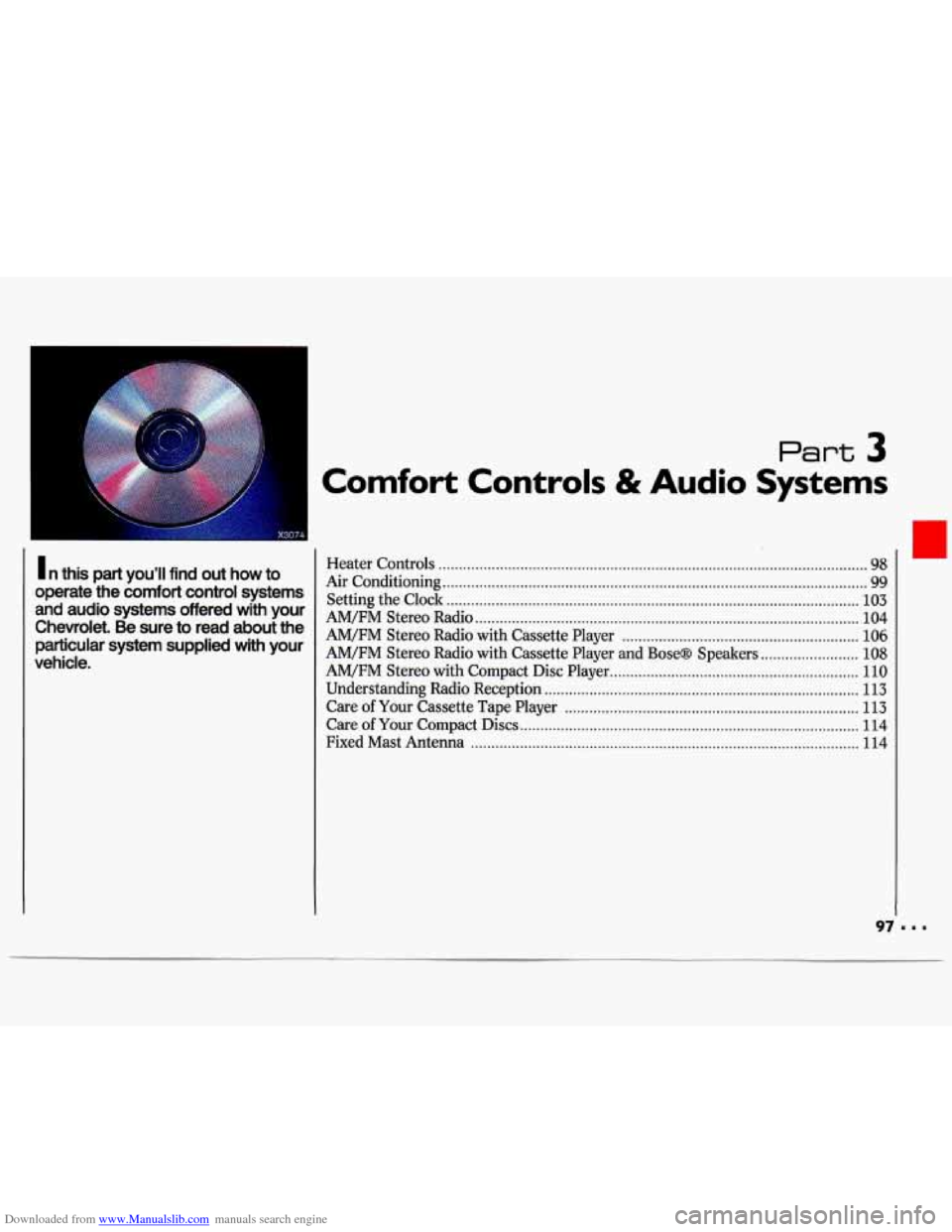
Downloaded from www.Manualslib.com manuals search engine 1 n this part you’ll find out how to
operate the comfort control systems and audio systems offered with your
Chevrolet
. Be sure to read about the
particular system supplied with your
vehicle
.
Heater Controls ........................................................................\
................................. 98
Air Conditioning ........................................................................\
................................ 99
Setting the Clock ........................................................................\
............................. 103
AM/FM Stereo Radio
........................................................................\
...................... 104
AM/FM Stereo Radio with Cassette Player
.......................................................... 106
AM/FM Stereo Radio with Cassette Player and BoseB Speakers ........................ 108
AM/FM Stereo with Compact Disc Player
............................................................. 110
Understanding Radio Reception
........................................................................\
..... 113
Care of Your Cassette Tape Player ........................................................................\
113
Care of Your Compact Discs ........................................................................\
........... 114
Fixed Mast Antenna ........................................................................\
....................... 114
Page 101 of 324
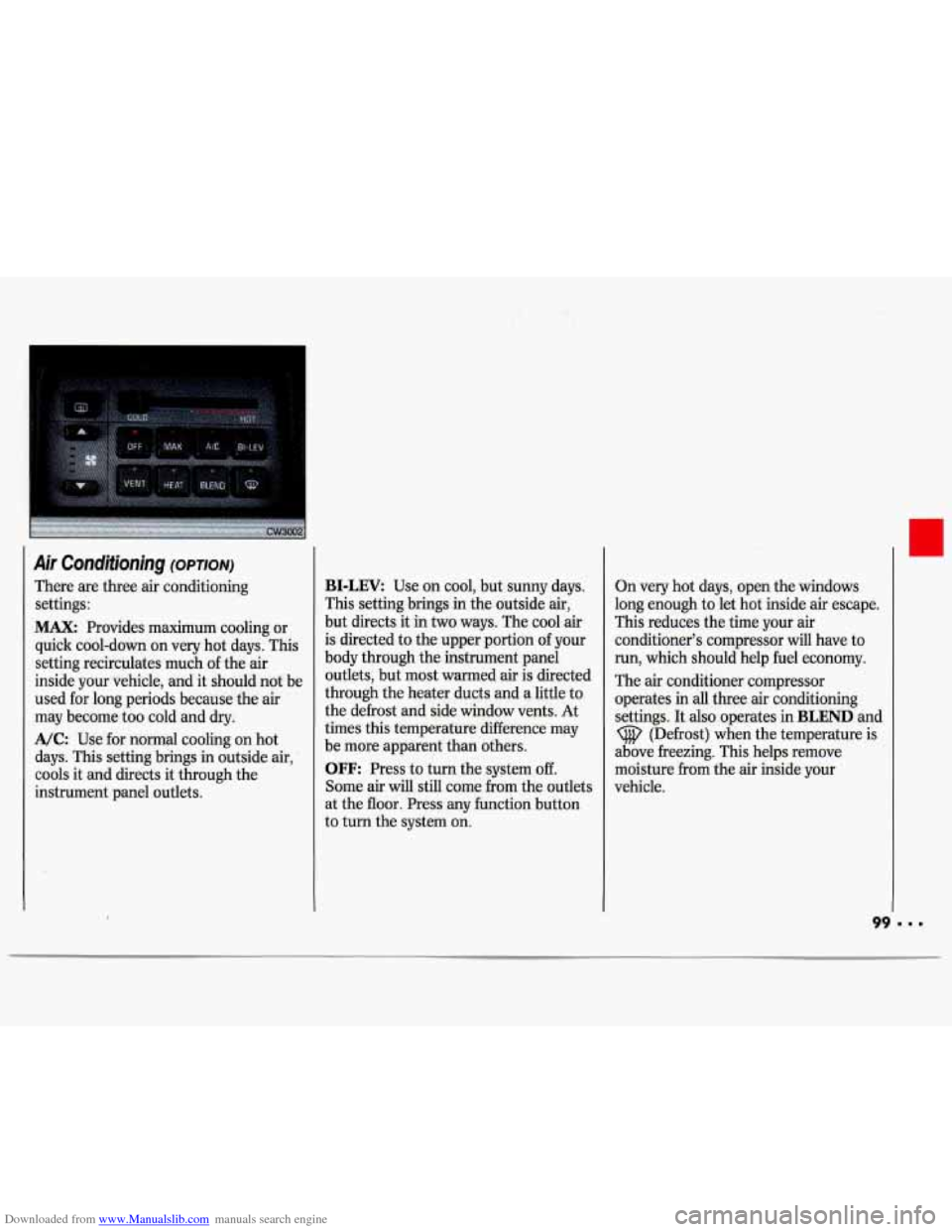
Downloaded from www.Manualslib.com manuals search engine Air Conditioning (OPTION)
There are three air conditioning
settings:
MAX: Provides maximum cooling or
quick cool-down on very hot days. This
setting recirculates much of the
air
inside your vehicle, and it should not be
used for long periods because the air
may become too cold and dry.
A/C Use for normal cooling on hot .
days. This setting brings in outside air,
cools it and directs it through the
instrument panel outlets.
BI-LEV Use on cool, but sunny days.
This setting brings in the outside air,
but directs it in two ways, The cool
air
is directed to the upper portion of your
body through the instrument panel
outlets, but most warmed air is directed
through the heater ducts and a little to
the defrost and side window vents. At
times this temperature difference may
be more apparent
than others.
OFF: Press to turn the system off.
Some air will still come from the outlets
at the floor. Press any function button
to turn the system on. On
very hot days, open the windows
long enough to let hot inside air escape.
This reduces the time your air
conditioner’s compressor will have to
run, which should help fuel economy.
The air conditioner compressor operates in
all three air conditioning
settings.
It also operates in BLEND and
ljjjl (Defrost) when the temperqture is
above freezing. This helps remove
moisture from the air inside your
vehicle.
Page 102 of 324
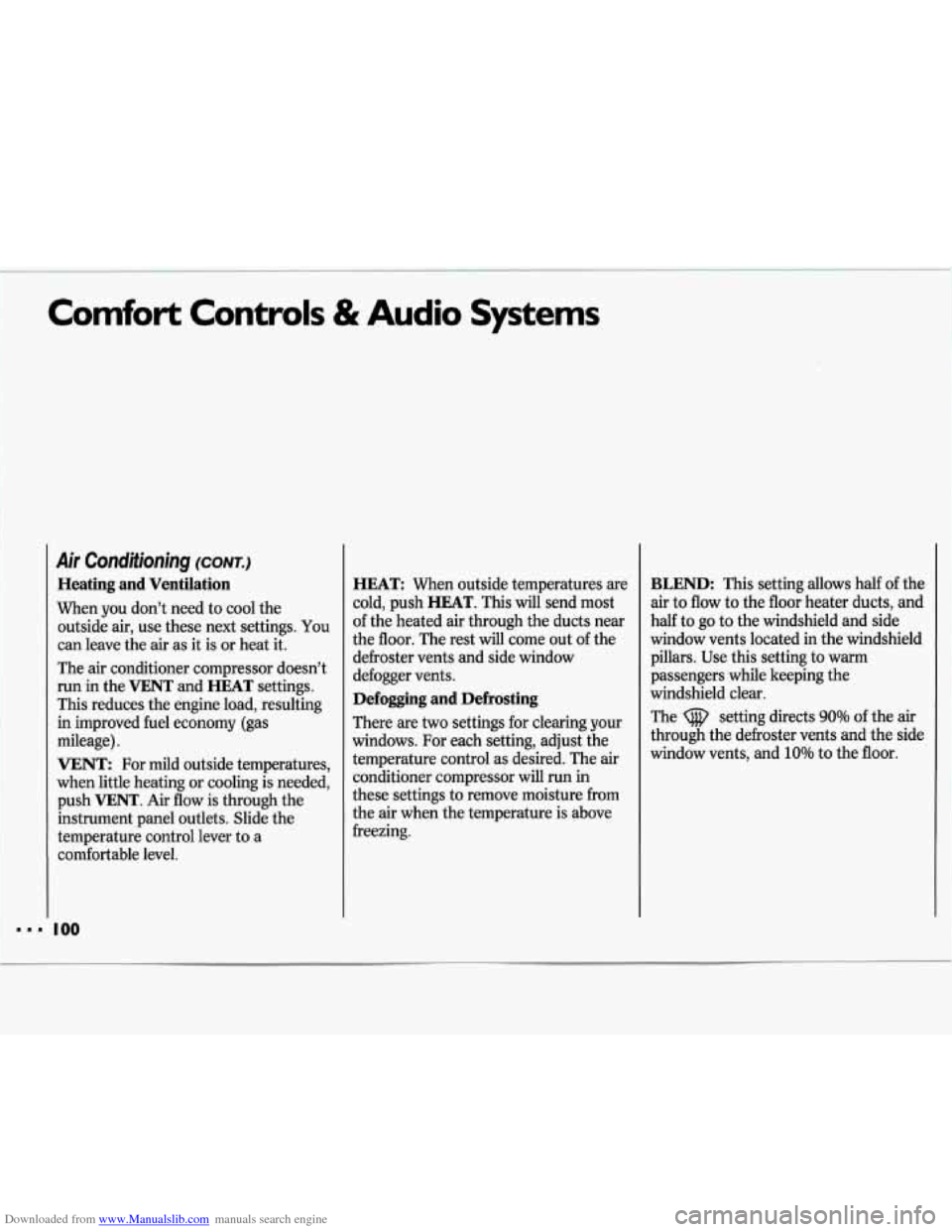
Downloaded from www.Manualslib.com manuals search engine Comfort Controls & Audio Systems
Air Conditioning (CONT.)
Heating and Ventilation
When you don’t need to cool the
outside air, use these next settings.
You
can leave the air as it is or heat it.
The air conditioner compressor doesn’t
run in the
VENT and HEAT settings.
This reduces the engine load, resulting
in improved fuel economy (gas
mileage).
VENT: For mild outside temperatures,
when little heating or cooling is needed,
push
VENT. Air flow is through the
instrument panel outlets. Slide the
temperature control lever to a
comfortable level.
HEAT When outside temperatures are
cold, push
HEAT. This will send most
of the heated air through the ducts near
the floor. The rest will come out of the
defroster vents and side window
defogger vents.
Defogging and Defrosting
There are two settings for clearing your
windows. For each setting, adjust the
temperature control as desired. The air
conditioner compressor will run in
these settings to remove moisture from
the air when the temperature is above
freezing.
BLEND: This setting allows half of the
air to flow to the floor heater ducts, and
half to
go to the windshield and side
window vents located in the windshield
pillars. Use this setting to warm
passengers while keeping the
windshield clear.
The setting directs
90
through the defroster vents and the side
window vents, and
10% to the floor.
Page 104 of 324
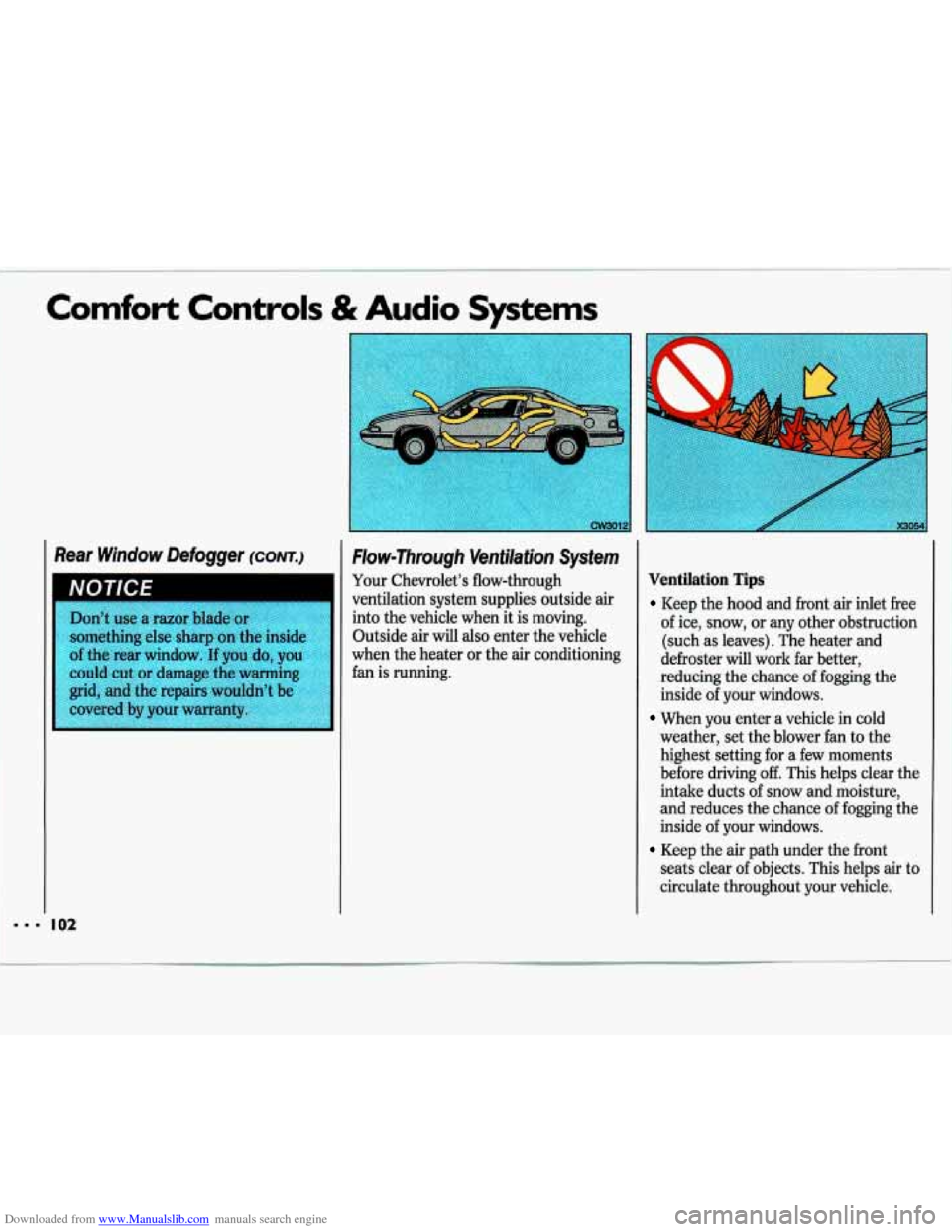
Downloaded from www.Manualslib.com manuals search engine I
I..
Comfort Controls & Audio Systems
Rear Window Defogger (CONT.)
Don’t use a razor blade 0.
something else sharp on the insid
of the rear window. If you do, you
could cut
or damage the warming
grid, and the repairs wouldn’t be
covered by your warranty.
I02
cw3012
Flow-Through Ventilation System
Your Chevrolet’s flow-through
ventilation system supplies outside air
into the vehicle when it is moving.
Outside air will
also enter the vehicle
when the heater or the air conditioning
fan is running.
I
Ventilation Tips
Keep the hood and front air inlet free
of ice, snow, or any other obstruction
(such as leaves). The heater and
defroster will work far better,
reducing the chance of fogging the
inside of your windows.
When you enter a vehicle in cold
weather, set the blower fan to the
highest setting for a few moments
before driving
off. This helps clear the
intake ducts of snow and moisture,
and reduces the chance of fogging the
inside of your windows.
Keep the air path under the front
seats clear
of objects. This helps air to
circulate throughout your vehicle.
Page 175 of 324
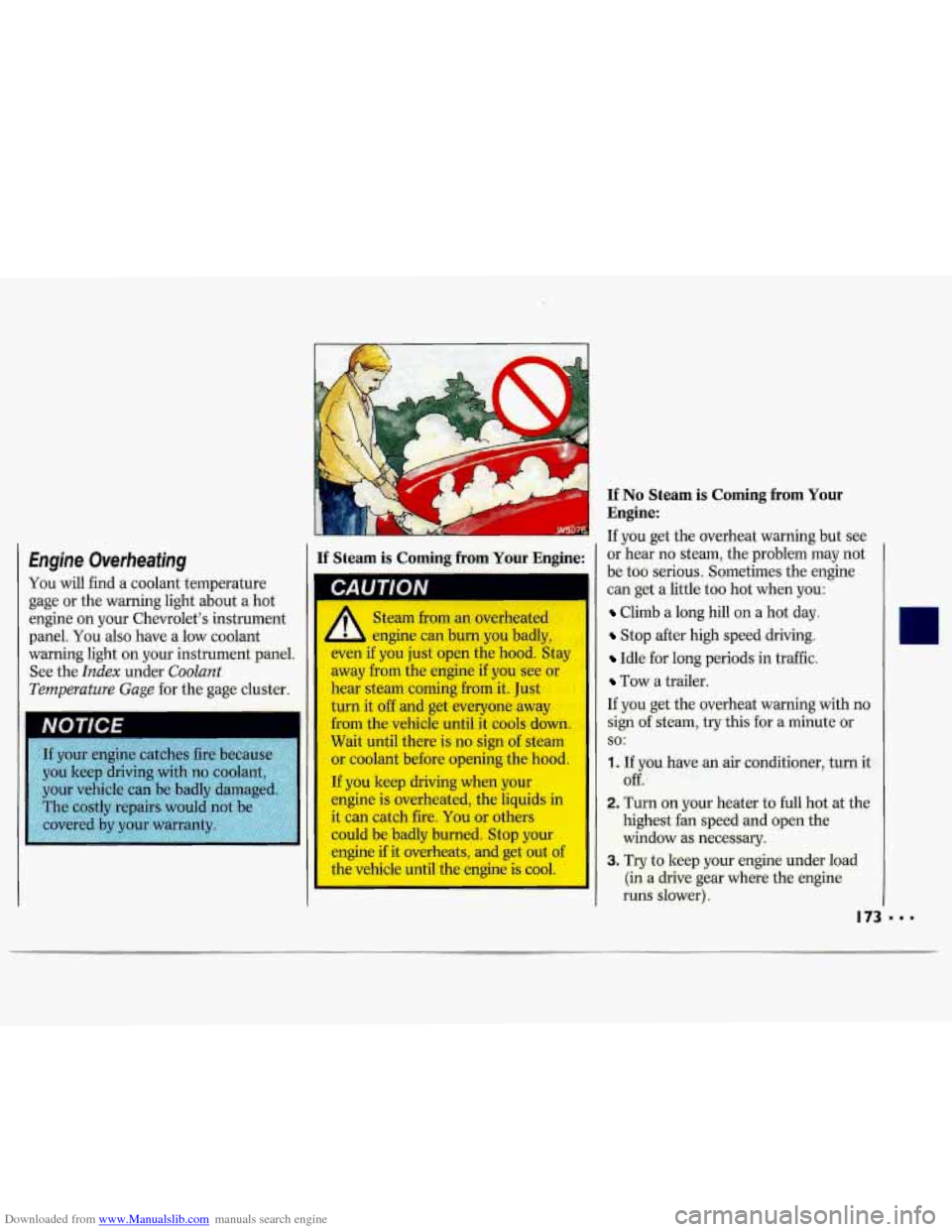
Downloaded from www.Manualslib.com manuals search engine If No Steam is Coming from Your
Engine:
If you get the overheat warning but see
or hear no stem, the problem may not
be
too serious. Sometimes the engine
can get
a little too hot when you:
Climb a long hill on a hot day.
Stop after high speed driving.
Idle for long periods in traffic.
Tow a trailer.
If you get the overheat warning with no
sign of steam, try this for a minute or
1. If you have an air conditioner, turn it
so:
Off.
I If Steam is Coming from Your Engine:
’I
Engine Overheating
You will find a coolant temperature
gage or the warning light about a hot
engine on your Chewolet’s instrument
panel. You also have a low coolant
warning light on your instrument panel.
See the
Index under Coolant
Temperature Gage for the gage cluster. Steam from
an overheated
engine can burn you badly,
/I‘ even if you just open the hood. Stay
away from the engine if you see or
hear steam coming from it. Just
turn it
off and get everyone away
from the vehicle until it cools down.
Wait until there is no sign of steam
or coolant before opening the hood.
If you keep driving when your
engine
is overheated, the liquids in
it can catch fire. You or others
could be badly burned. Stop your
engine
if it overheats, and get out of
the vehicle until the engine
is cool.
2. Tm on your heater to full hot at the
I I highest fan speed and open the
window as necessary.
3. Try to keep your engine under load
(in a drive gear where the engine
I runs slower). IL
Page 232 of 324
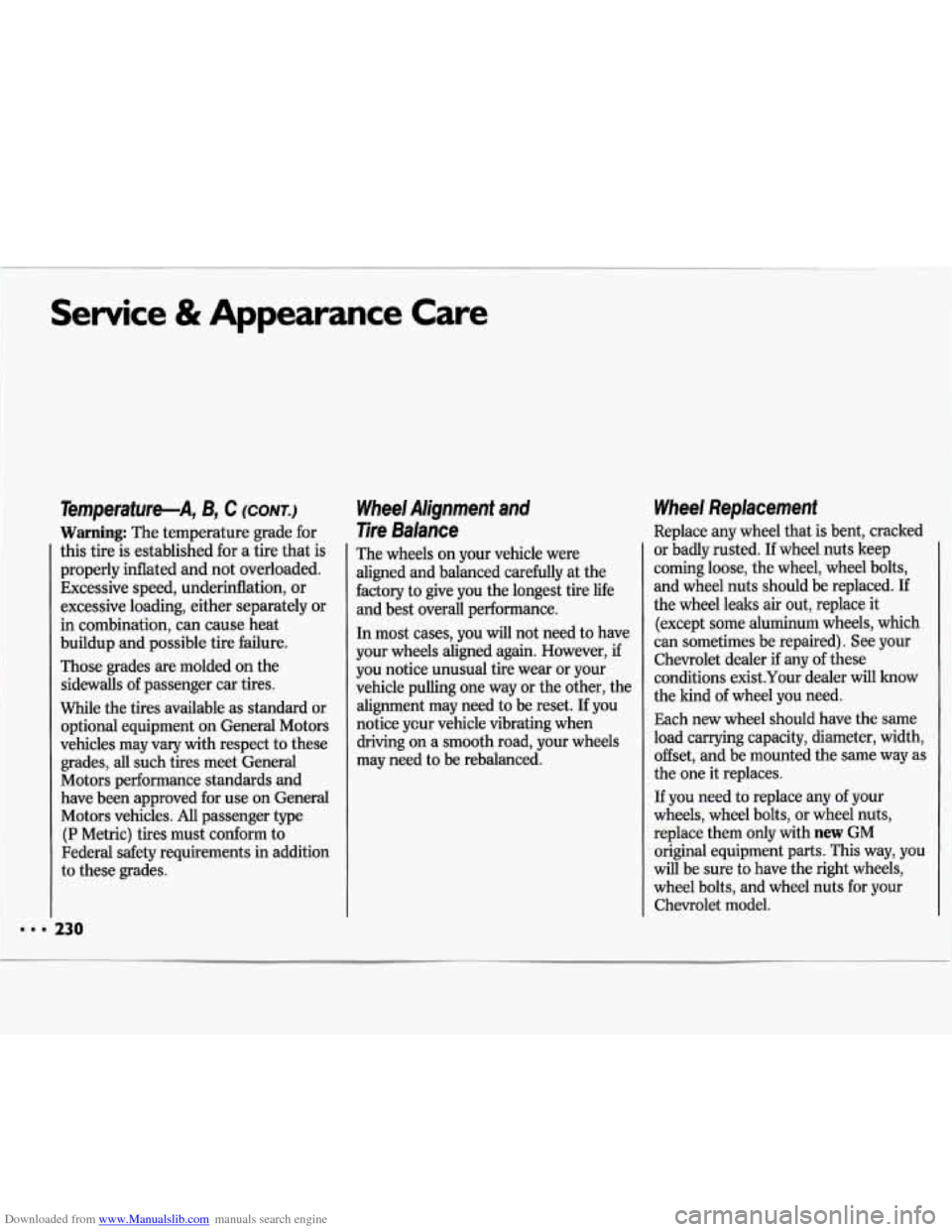
Downloaded from www.Manualslib.com manuals search engine Service & Appearance Care
Temperature-A, B, C (CONT.)
Warning: The temperature grade for
this tire is established for a tire that is
properly inflated and not overloaded.
Excessive speed, underinflation, or
excessive loading, either separately or
in combination, can cause heat
buildup and possible tire failure.
Those grades are molded on the
sidewalls of passenger car tires.
While the tires available as standard or
optional equipment on General Motors
vehicles may vary with respect to these
grades, all such tires meet General
Motors performance standards and
have been approved for use on General
Motors vehicles. All passenger type
(P Metric) tires must conform to
Federal safety requirements in addition
to these grades.
230
Wheel Alignment and
Tire Balance
The wheels on your vehicle were
aligned and balanced carefully at the
factory to give you the longest tire life
and best overall performance.
In most cases, you
will not need to have
your wheels aligned again. However, if
you notice unusual tire wear or your
vehicle pulling one way or the other, the
alignment may need to be reset. If you
notice ycur vehicle vibrating when
driving on a smooth road, your wheels
may need to be rebalanced.
Wheel Replacement
Replace any wheel that is bent, cracked
or badly rusted. If wheel nuts keep
I
coming loose, the wheel, wheel bolts,
and wheel nuts should be replaced. If
the wheel leaks air out, replace
it
(except some aluminum wheels, which
can sometimes be repaired). See your
Chevrolet dealer if any
of these
conditions exist.Your dealer will know
I
the kind of wheel you need.
Each new wheel should have the same
load carrying capacity, diameter, width,
offset, and be mounted the same way
as
the one it replaces.
If you need to replace any
of your
wheels, wheel bolts, or wheel nuts,
replace them only with
new GM
original equipment parts. This way, you
will be sure to have the right wheels,
wheel bolts, and wheel nuts for your
Chevrolet model.